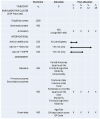A cluster randomised controlled trial of advice, exercise or multifactorial assessment to prevent falls and fractures in community-dwelling older adults: protocol for the prevention of falls injury trial (PreFIT)
- PMID: 26781504
- PMCID: PMC4735205
- DOI: 10.1136/bmjopen-2015-009362
A cluster randomised controlled trial of advice, exercise or multifactorial assessment to prevent falls and fractures in community-dwelling older adults: protocol for the prevention of falls injury trial (PreFIT)
Abstract
Introduction: Falls are the leading cause of accident-related mortality in older adults. Injurious falls are associated with functional decline, disability, healthcare utilisation and significant National Health Service (NHS)-related costs. The evidence base for multifactorial or exercise interventions reducing fractures in the general population is weak. This protocol describes a large-scale UK trial investigating the clinical and cost-effectiveness of alternative falls prevention interventions targeted at community dwelling older adults.
Methods and analysis: A three-arm, pragmatic, cluster randomised controlled trial, conducted within primary care in England, UK. Sixty-three general practices will be randomised to deliver one of three falls prevention interventions: (1) advice only; (2) advice with exercise; or (3) advice with multifactorial falls prevention (MFFP). We aim to recruit over 9000 community-dwelling adults aged 70 and above. Practices randomised to deliver advice will mail out advice booklets. Practices randomised to deliver 'active' interventions, either exercise or MFFP, send all trial participants the advice booklet and a screening survey to identify participants with a history of falling or balance problems. Onward referral to 'active' intervention will be based on falls risk determined from balance screen. The primary outcome is peripheral fracture; secondary outcomes include number with at least one fracture, falls, mortality, quality of life and health service resource use at 18 months, captured using self-report and routine healthcare activity data.
Ethics and dissemination: The study protocol has approval from the National Research Ethics Service (REC reference 10/H0401/36; Protocol V.3.1, 21/May/2013). User groups and patient representatives were consulted to inform trial design. Results will be reported at conferences and in peer-reviewed publications. A patient-friendly summary of trial findings will be published on the prevention of falls injury trial (PreFIT) website. This protocol adheres to the recommended SPIRIT Checklist. Amendments will be reported to relevant regulatory parties.
Trial registration number: ISRCTN 71002650; Pre-results.
Keywords: Exercise; Falls prevention; Fracture; GERIATRIC MEDICINE; PRIMARY CARE.
Published by the BMJ Publishing Group Limited. For permission to use (where not already granted under a licence) please go to http://www.bmj.com/company/products-services/rights-and-licensing/
Figures



Similar articles
-
The design and development of a complex multifactorial falls assessment intervention for falls prevention: The Prevention of Falls Injury Trial (PreFIT).BMC Geriatr. 2017 Jun 1;17(1):116. doi: 10.1186/s12877-017-0492-6. BMC Geriatr. 2017. PMID: 28571563 Free PMC article. Clinical Trial.
-
Population-based interventions for preventing falls and fall-related injuries in older people.Cochrane Database Syst Rev. 2024 Jan 5;1(1):CD013789. doi: 10.1002/14651858.CD013789.pub2. Cochrane Database Syst Rev. 2024. PMID: 38180112 Free PMC article.
-
Fall prevention interventions in primary care to reduce fractures and falls in people aged 70 years and over: the PreFIT three-arm cluster RCT.Health Technol Assess. 2021 May;25(34):1-114. doi: 10.3310/hta25340. Health Technol Assess. 2021. PMID: 34075875 Free PMC article. Clinical Trial.
-
Screening and Intervention to Prevent Falls and Fractures in Older People.N Engl J Med. 2020 Nov 5;383(19):1848-1859. doi: 10.1056/NEJMoa2001500. N Engl J Med. 2020. PMID: 33211928 Clinical Trial.
-
Interventions to Prevent Falls in Community-Dwelling Older Adults: A Systematic Review for the U.S. Preventive Services Task Force [Internet].Rockville (MD): Agency for Healthcare Research and Quality (US); 2018 Apr. Report No.: 17-05232-EF-1. Rockville (MD): Agency for Healthcare Research and Quality (US); 2018 Apr. Report No.: 17-05232-EF-1. PMID: 30234932 Free Books & Documents. Review.
Cited by
-
The design and development of a complex multifactorial falls assessment intervention for falls prevention: The Prevention of Falls Injury Trial (PreFIT).BMC Geriatr. 2017 Jun 1;17(1):116. doi: 10.1186/s12877-017-0492-6. BMC Geriatr. 2017. PMID: 28571563 Free PMC article. Clinical Trial.
-
Multifactorial and multiple component interventions for preventing falls in older people living in the community.Cochrane Database Syst Rev. 2018 Jul 23;7(7):CD012221. doi: 10.1002/14651858.CD012221.pub2. Cochrane Database Syst Rev. 2018. PMID: 30035305 Free PMC article.
-
Population-based interventions for preventing falls and fall-related injuries in older people.Cochrane Database Syst Rev. 2024 Jan 5;1(1):CD013789. doi: 10.1002/14651858.CD013789.pub2. Cochrane Database Syst Rev. 2024. PMID: 38180112 Free PMC article.
-
The importance of different frailty domains in a population based sample in England.BMC Geriatr. 2020 Jan 15;20(1):16. doi: 10.1186/s12877-019-1411-9. BMC Geriatr. 2020. PMID: 31941440 Free PMC article.
-
Home visits: A new screening tool for frailty? A retrospective exploratory study.J Family Med Prim Care. 2018 Sep-Oct;7(5):1007-1011. doi: 10.4103/jfmpc.jfmpc_159_18. J Family Med Prim Care. 2018. PMID: 30598948 Free PMC article.
References
-
- Association BO. The care of patients with fragility fracture. London: British Orthopaedic Association, 2007.
Publication types
MeSH terms
Associated data
Grants and funding
LinkOut - more resources
Full Text Sources
Other Literature Sources
Medical
